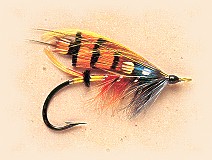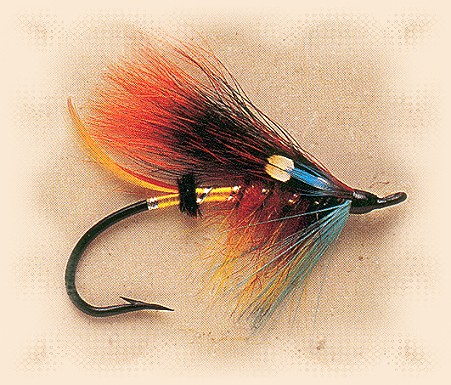Various sources date the creation of hairwing flies anywhere
between 1795 and the early 1900s. Some feel the change to hairwing
from the multi-feathered wing flies was intentional. That is, the
hair acted in a more natural manner, being "more mobile while many of
the feather wings are stiff. They pulsate in the current and act
live. Are are juicily translucent while many of the feather-wings are
opaque." Quoted from Atlantic Salmon Flies & Fishing by
Joseph D. Bates, Jr.

Comparing the hairwing (above) to the featherwing Durham Ranger (shown right),
the only differences seem to be in the actual wing. Disregarding the
more lifelike appearance in the water, the creation of could well
have been of necessity. The tyers just did not have the required
materials and substituted what they had available.
A great story, from Atlantic Salmon Flies & Fishing again,
"One story, which is interesting regardless of its degree of authenticity,
tells of immigrants who came from the British Isles to Newfoundland in the
eighteenth century, which is very early in the history of fly fishing.
They brought with them cattle, sheep and dogs, plus other essentials of
colonial life, including fish hooks. Although fishing then was mainly
done with nets and by other quantity production means, the colonists
occasionally fished with long fly-rods for sport. Since this was in the
pre-Kelso era, fancy flies not only were unknown, but their ingredients
for the most part unavailable. People used what they had, and they quite
sensibly named each fly from its ingredients, so its name told the
neighbors exactly what was used to catch the "big one" of the day.
When it got nosed around, for example that old Dave Kirke took a whopper
on a Red Cow fly, everybody knew that this came from a Hereford
he had brought from England, and that it had a body dubbed from the
underfur of the red cow and a wing made of the guard hairs of the
same red cow."
The current availability of all sorts of natural and synthetic materials
continues to spawn a new generation of flies of all types, from Saltwater
Flies and Trout Flies, to Atlantic Salmon and Spey flies.
Durham Ranger Hairwing
(conversion by Charlie Krom)
Tag: Oval silver tinsel.
Tip: Yellow floss.
Tail: Golden Pheasant crest and Indian Crow.
Butt: Black Ostrich herl.
Body: Lemon floss, orange, fiery brown, and black Seal's fur in equal sections.
Ribbing: Flat silver and oval silver tinsel.
Body Hackle: Yellow dyed Badger.
Hackle: Light Blue.
Wing: Orange dyed Squirrel tail.
Shoulder: Jungle Cock eye and blue Chatterer.
Head: Black.
Classic Durham Ranger
(Hale, How to Tie Salmon Flies)
Tag: Silver tinsel; yellow floss.
Tail: Topping; Indian Crow.
Butt: Black Ostrich herl.
Body: Two turns of orange floss; two turns of dark orange Seal fur,
the rest black Seal fur.
Ribbing: Silver lace; silver tinsel.
Hackle: White coch-y-bonddu dyted orange.
Wing: Four tippets, overlapping (two on each side) and
enveloping two projecting Jungle Cock; topping.
Cheeks: Chatterer.
Horns: Blue Macaw.
Head: Black.
For yet another photograph and different recipe for the 'Classic' Durham Ranger, see
/features/oldflies/part109.php
~ DLB
|



